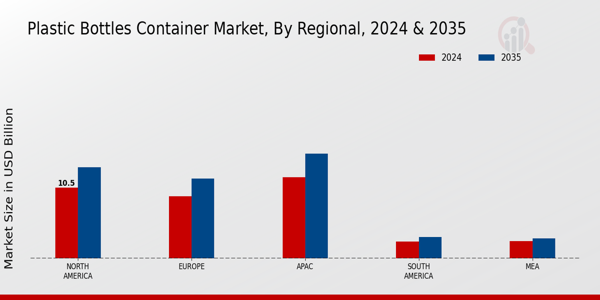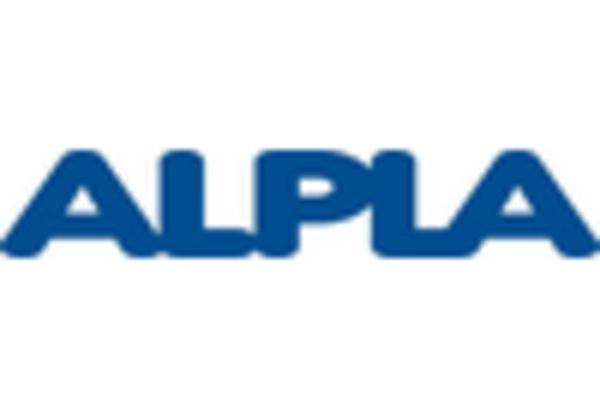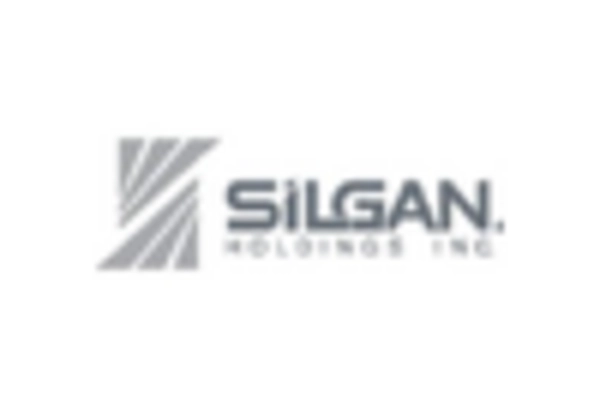Growth in Beverage Industry
The expansion of the beverage industry serves as a significant catalyst for the Plastic Bottles Container Market. With The Plastic Bottles Container projected to reach approximately 1.5 trillion dollars by 2026, the demand for plastic bottles is expected to rise correspondingly. This growth is driven by the increasing consumption of bottled water, soft drinks, and alcoholic beverages, which collectively account for a substantial portion of plastic bottle usage. Furthermore, the convenience and portability of plastic bottles make them a preferred choice among consumers. As beverage companies strive to enhance their product offerings, the need for innovative and attractive packaging solutions becomes paramount. Thus, the Plastic Bottles Container Market is poised for robust growth, fueled by the beverage sector's expansion.
Rising Demand for Eco-Friendly Packaging
The increasing consumer awareness regarding environmental sustainability appears to be a pivotal driver for the Plastic Bottles Container Market. As more consumers seek eco-friendly alternatives, manufacturers are compelled to innovate and produce biodegradable and recyclable plastic bottles. This shift is evidenced by a reported 20 percent increase in the production of sustainable packaging solutions over the past year. Companies are investing in research and development to create materials that minimize environmental impact, which could potentially reshape market dynamics. The emphasis on sustainability not only aligns with consumer preferences but also meets regulatory requirements aimed at reducing plastic waste. Consequently, the Plastic Bottles Container Market is likely to witness a surge in demand for products that adhere to these eco-conscious standards.
Technological Advancements in Manufacturing
Technological innovations in manufacturing processes are likely to play a crucial role in shaping the Plastic Bottles Container Market. Advanced techniques such as blow molding and injection molding have enhanced production efficiency and reduced costs. These technologies enable manufacturers to produce lightweight and durable plastic bottles, which are increasingly favored by consumers. Moreover, automation and smart manufacturing practices are being adopted to streamline operations, thereby improving product quality and consistency. The integration of these technologies not only meets the rising demand for high-quality packaging but also aligns with sustainability goals by minimizing waste during production. As a result, the Plastic Bottles Container Market is expected to benefit from these advancements, leading to increased competitiveness and market share.
Regulatory Support for Recycling Initiatives
Regulatory frameworks promoting recycling initiatives are emerging as a vital driver for the Plastic Bottles Container Market. Governments worldwide are implementing policies aimed at reducing plastic waste and encouraging recycling practices. For instance, several countries have introduced mandates requiring a certain percentage of recycled content in plastic products, which could significantly impact production processes. This regulatory support fosters a circular economy, where plastic bottles are reused and recycled, thereby reducing the demand for virgin materials. As companies adapt to these regulations, they are likely to invest in recycling technologies and partnerships with recycling facilities. Consequently, the Plastic Bottles Container Market stands to gain from these initiatives, as they not only enhance sustainability but also create new business opportunities.
Increasing Popularity of Personal Care Products
The rising popularity of personal care products is emerging as a noteworthy driver for the Plastic Bottles Container Market. As consumers increasingly prioritize personal grooming and hygiene, the demand for packaging solutions that cater to these products is on the rise. The personal care sector, which includes items such as shampoos, lotions, and cosmetics, is projected to grow significantly, thereby increasing the need for plastic bottles. This trend is further supported by the shift towards online retail, where attractive and functional packaging plays a crucial role in consumer purchasing decisions. As brands seek to differentiate themselves in a competitive market, the design and functionality of plastic bottles become paramount. Thus, the Plastic Bottles Container Market is likely to experience growth driven by the expanding personal care sector.


















Leave a Comment